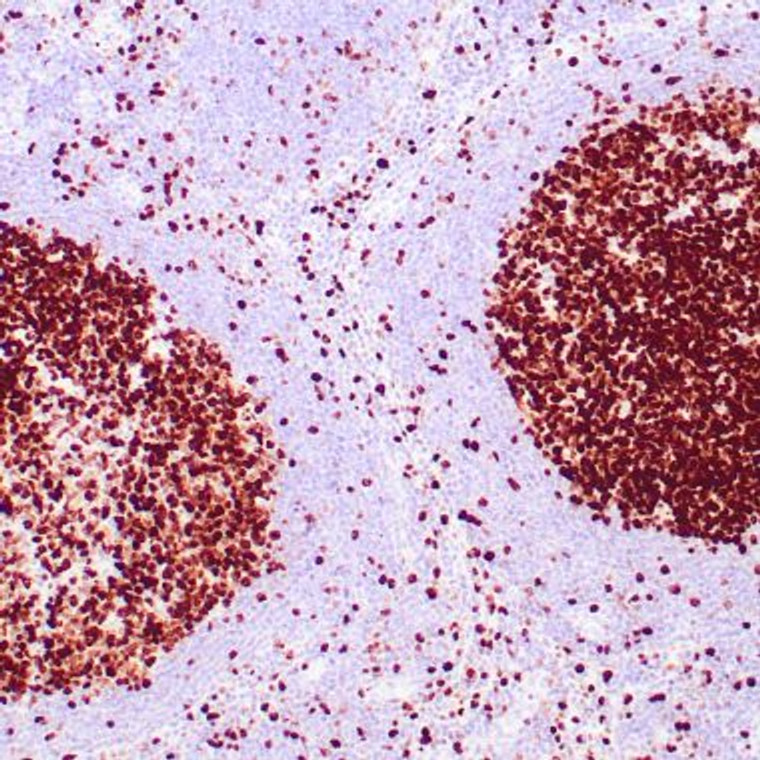| Host: |
Mouse |
| Applications: |
IHC-P |
| Reactivity: |
Human |
| Note: |
STRICTLY FOR FURTHER SCIENTIFIC RESEARCH USE ONLY (RUO). MUST NOT TO BE USED IN DIAGNOSTIC OR THERAPEUTIC APPLICATIONS. |
| Short Description: |
Mouse monoclonal antibody anti-Ki-67 (2293-2478aa) is suitable for use in Immunohistochemistry research applications. |
| Clonality: |
Monoclonal |
| Clone ID: |
ZM67 |
| Conjugation: |
Unconjugated |
| Isotype: |
IgG/Kappa |
| Formulation: |
Tris-HCI buffer containing stabilizing protein (BSA) and <0.1% ProClin |
| Purification: |
Affinity purified |
| Dilution Range: |
1:100‐200 |
| Storage Instruction: |
Store at 2‐8°C for up to 24 months. Predilute: Ready to use, no reconstitution necessary. Concentrate: Use dilution range and appropriate lab‐standardized diluent. Stability after dilution: 7 days at 24°C, 3 months at 2‐8°C, 6months at ‐20°C. |
| Gene Symbol: |
MKI67 |
| Gene ID: |
4288 |
| Uniprot ID: |
KI67_HUMAN |
| Immunogen Region: |
2293-2478aa |
| Specificity: |
Positive control: Spleen, tonsil, or breast carcinomas |
| Immunogen: |
Recombinant human Ki67 protein fragment (around aa2293-2478) |
| Post Translational Modifications | Phosphorylated. Hyperphosphorylated in mitosis. Hyperphosphorylated form does not bind DNA. |
| Function | Required to maintain individual mitotic chromosomes dispersed in the cytoplasm following nuclear envelope disassembly. Associates with the surface of the mitotic chromosome, the perichromosomal layer, and covers a substantial fraction of the chromosome surface. Prevents chromosomes from collapsing into a single chromatin mass by forming a steric and electrostatic charge barrier: the protein has a high net electrical charge and acts as a surfactant, dispersing chromosomes and enabling independent chromosome motility. Binds DNA, with a preference for supercoiled DNA and AT-rich DNA. Does not contribute to the internal structure of mitotic chromosomes. May play a role in chromatin organization. It is however unclear whether it plays a direct role in chromatin organization or whether it is an indirect consequence of its function in maintaining mitotic chromosomes dispersed (Probable). |
| Protein Name | Proliferation Marker Protein Ki-67Antigen Identified By Monoclonal Antibody Ki-67Antigen Ki-67Antigen Ki67 |
| Cellular Localisation | ChromosomeNucleusNucleolusAssociates With The Surface Of The Mitotic ChromosomeThe Perichromosomal LayerAnd Covers A Substantial Fraction Of The Mitotic Chromosome SurfaceAssociates With Satellite Dna In G1 PhaseBinds Tightly To Chromatin In InterphaseChromatin-Binding Decreases In Mitosis When It Associates With The Surface Of The Condensed ChromosomesPredominantly Localized In The G1 Phase In The Perinucleolar RegionIn The Later Phases It Is Also Detected Throughout The Nuclear InteriorBeing Predominantly Localized In The Nuclear Matrix |
| Alternative Antibody Names | Anti-Proliferation Marker Protein Ki-67 antibodyAnti-Antigen Identified By Monoclonal Antibody Ki-67 antibodyAnti-Antigen Ki-67 antibodyAnti-Antigen Ki67 antibodyAnti-MKI67 antibody |
Information sourced from Uniprot.org
12 months for antibodies. 6 months for ELISA Kits. Please see website T&Cs for further guidance







